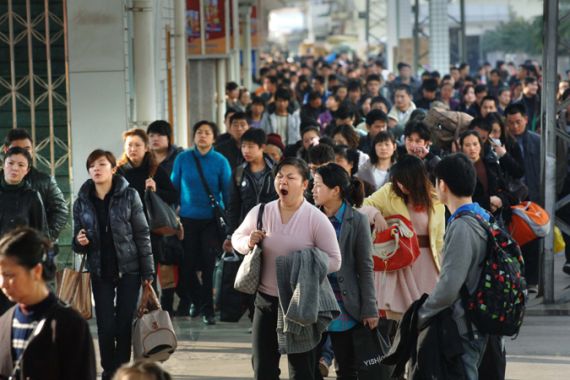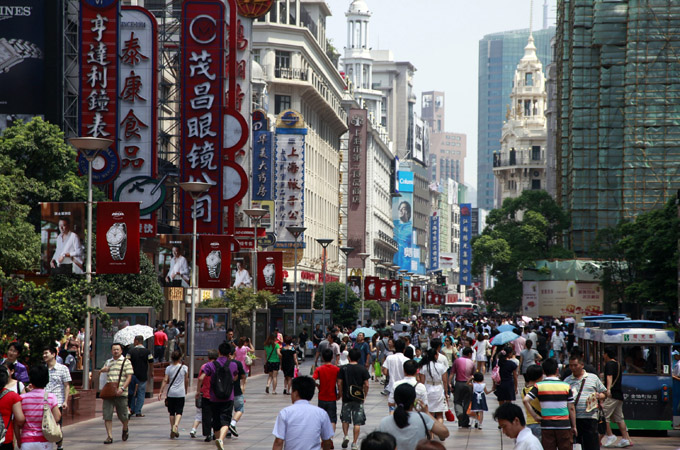China’s middle class as environmental frontier
China’s accelerated growth has parallels in the emergence of a new urban middle class.

 |
| There is high level of environmental consciousness and awareness among educated Chinese people [EPA] |
Wageningen, The Netherlands – China’s accelerated growth parallels the emergence of a new urban middle class. Studies estimate that 14 per cent of the current Chinese population belongs to the middle class, and this percentage will only grow further.
These citizens are economically better off, well-educated, no longer engaged in agricultural or industrial production, but rather in services, have a modern and outward looking world view, and are optimistic about the dazzling opportunities that lie ahead of them. Is this new middle class an environmental catastrophe for planet earth?
Keep reading
list of 4 itemsEnergy summit seeks to curb cooking habits that kill millions every year
Thousands evacuate as wildfire grows ‘dramatically’ in western Canada
Guardians of the glaciers – life alongside Pakistan’s vanishing ice
First and foremost, this new middle class represents China as a consumer society. Its purchasing power brings cars, durable electric and electronic equipment, (inter)national tourism travellings, larger houses and a meat-based diet within reach of the masses. The growth in car sales during the past decade is telling – rising each year between 20 and 30 per cent. This made China the world’s largest car producer and the world’s largest energy user.
More consumption means more energy and material use, more intensive (agricultural and industrial) production, more waste, and more pollution. Increased production for exports further contributes to this. The consequences are shown in WWF’s China Ecological Footprint Report 2010: a rapidly increasing national ecological footprint (with a widening gap between the wealthy and poor).
Hence it is not without reason that this new middle class is widely associated with spreading pollution and unsustainable behaviour.
A growing middle class
So far, not much special to report. Around the world consumption levels grow with prosperity, resulting in larger use of natural resources and more pollution. The pattern in China pretty much reflects what happened with the emerging middle class in the US after the depression and in Europe after World War II.
|
“Around the world, consumption levels grow with prosperity, resulting in larger use of natural resources and more pollution.” – Arthur Mol |
Governments have been actively involved in driving this “consumer culture”. Economic development through consumer spending is a key government policy in contemporary China, and the middle class is the main target. Still, national differences exist in the level of material consumption (and thus ecological footprint). The US per capita ecological footprint is twice that of Europe. Will the Chinese middle class resemble a European or an American consumer profile?
China’s new middle class are not just unsustainable quantity-consumers and polluters. Opinion polls show high and growing levels of environmental consciousness and awareness, especially among the more educated, richer and (surprisingly) male Chinese urban residents.
Market research equally reports mounting interest in green products among the middle class, triggered by food scandals on milk, meat and vegetables, toxics released from toys and furniture, industrial accidents, and continuing high levels of water and air pollution. But green, bio, natural or organic products have in China a different connotation than in Western countries. Green refers to “trustworthy”, “trendy and modern”, “high quality products and services” and “safe and healthy”, and less to low pollution or nature protection. The middle class is highly interested in the latest brands, quality control systems, safe food, and non-toxic toys and furniture.
But Chinese consumers are not yet massively buying environmentally sound products. The reasons for this? Middle class consumers are still very price-sensitive (and thus difficult to seduce paying a green premium), lack sophisticated environmental knowledge, and are ill-informed on the environmental profile of products.
Most of all, there is widespread confusion and distrust on environmental claims, labels and standards that swamp the Chinese market. The Chinese middle class lacks confidence in green products.
According to Chinese government statistics, the value of the organics market in 2010 was only US $1.55bn (roughly one fifth of the German organics market). Still, China’s organics market is expected to quadruple in 2015 and domestic and international business interest is expanding exponentially. Western-style Community Supported Agriculture projects, where middle class consumers directly buy from trusted safe food producers, are also mounting.
| The Stream – China’s class war? |
The middle class movement
There’s another manner in which China’s middle class starts furthering environmental interests. In the 1960s and 1970s, the middle class in, among others, Northern America and Europe formed the backbone of an emerging environmental movement.
Today, China’s middle class is well represented in the thousands and thousands of recently established environmental organisations. Their activities range from voluntary cleanup, environmental awareness raising and education, green consumption, petitions, information disclosure, complaining in the media, to public protests or so-called “mass incidents”.
Two-thirds of the 180,000 “mass incidents” in 2010 involved angry farmers fighting land rights and grabs. But where farmer protests often remain unnoticed, the urban middle class environmental protests are visible and increasingly effective. The middle class has the environmental knowledge, access to resources, the organisational skills, and necessary contacts with the media, state officials and international organisations.
Middle class environmentalists make effective use of the growing political room provided for civil society protests. National Chinese authorities often welcome environmentalists for their counter-veiling environmental power, now that profit-driven polluting markets are getting out of state control. So, national environmental authorities directed mandatory disclosure of environmental information, provided for participation of citizens in environmental decisions, and allow environmental criticism in local and national media.
Middle class environmentalists thus drive not just environmental reforms, but also push for participation, freedom of information and democracy. Opposition and obstruction against this is most fierce locally, where local authorities ally with business.
|
“Don’t underestimate the Chinese middle class.” – Arthur Mol |
In the end, greening middle class consumption in China lies with the state. More precisely: with the relation between the middle class and the state elite. In China, the state is able and willing to constrain a purely economic-oriented logic of mass consumption.But it cannot successfully do so without approval and legitimation by the middle class.
The middle class recognises environmental protection as a legitimate reason to confine unbridled, unsustainable consumption. Hence, we see the green awareness and outlook of the new middle class mirrored and institutionalised in state authorities’ five year plans (the 12th being the latest), priority investments, laws and policies, international negotiations, research and development spendings, assessment indicators for officials, education programmes, product requirements and the like.
While the political elite still decides on (environmental) priorities in these areas, it does so with a middle class frame in mind. Besides economic growth, national security, and social cohesion, environmental protection is now fully part of that frame.
Green electricity, clean cars, a ban on plastic bags, strong punishments in food scandals: China’s consumption is becoming more sustainable, although it has a long way to go. But compared with China’s acceleration, the US seems to stand still. The Chinese middle class will become the environmental vanguard, because it is backed by the state.
Don’t underestimate the Chinese middle class: they are coming, they demand their share in consumption – but they also form a state-backed driver of sustainability.
Arthur PJ Mol is chair and professor in Environmental Policy at Wageningen University. He is also director of the Wageningen School of Social Sciences and also professor of Environmental Policy at Renmin University, Beijing. He is joint editor of Environmental Politics.
The views expressed in this article are the author’s own and do not necessarily reflect Al Jazeera’s editorial policy.
